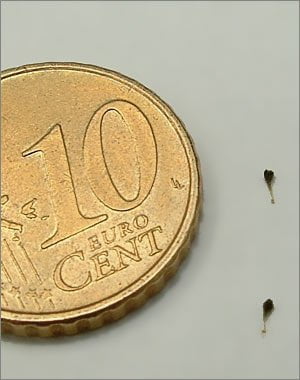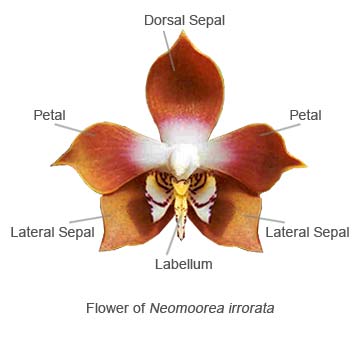
Now for the Science Bit!
So what exactly are orchids? what makes them different to other plants? and why are they given such unpronounceable Latin names? Here we try to explain. Understand this and you are on the way to becoming an orchid expert!
Orchid Names
If there is one thing that newcomers find daunting about orchids it is their Latin names. These however must be used because Latin is the universal language of all biological classification (taxonomy) and not just for orchids. If we relied on colloquial names such as “Butterfly Orchid” for identification then there would be total confusion because many different orchids are known as butterfly orchids. The Latin name unequivocally identifies the plant regardless of where it is discussed. In the past classification was based upon plant characteristics but today it is chiefly though not entirely decided on its DNA “fingerprint”.
The first Latin word in an orchids name gives the genus to which it belongs. The genus (plural genera) is a group of genetically closely related orchids within the wider orchid family. Often plants of a given genera are readily identifiable even by newcomers. There are almost 900 orchid genera but you will be relieved to hear that only around 60 are popular with growers.
The second Latin word used in an orchids name refers to the species within the genera. The species can be thought of as the most closely related individuals within a genera and which generally appear highly distinctive, are fertile and breed true. An orchid genus can contain over a thousand species or as little as one. There are estimated to be about 35,000 species from the 900 genera.
The Orchid Plant
As you now know, orchids can be found growing in vastly different habitats and so it is not surprising that there has evolved variation in the plant structure reflecting differences in terms of sunlight, seasonal changes and water availability. Many of the tropical epiphytic orchids possess swollen bulb-like structures termed pseudobulbs which are highly variable between genera. When new leaves develop as a side shoot of the previous years growth the base of the new shoot will swell into a pseudobulb towards the end of the season often in preparation for a period of dormancy. Those tropical genera which do not have pseudobulbs usually have thick succulent leaves which perform the same function. If you examine the healthy roots of a tropical orchid you will see they are typically thick and white with green tips. The root absorbs water and air humidity like a sponge through this epidermis called the velamen. The roots have an additional function in securing the plant to the tree branch on which it grows. The roots are not adapted to be immersed for long periods in water and so they rot easily when this is done in cultivation. Epiphytic roots in the wild receive water from heavy rainfall that drains freely through the detritus in which they live.
Orchids in temperate climates produce neither pseudobulbs nor succulent stems instead their storage solutions are underground tubers, corms or rhizomes which concentrate nutrients and sugars from the previous season as the leaves die back in late summer before entering winter dormancy.
People frequently ask how long do orchids live? Most orchids when kept disease-free and their cultural requirements met can be kept growing almost indefinitely!
The Orchid Flower
There is perhaps no more astounding phenomena in the botanical world than the evolution of orchid flowers as specialised genetically tailored devices of structure and of fragrance to entice agents of pollination whether they be insects, bats or birds. Orchids being plants, have left no fossil record but pollen has been retrieved from an insect encased in amber dating back 20 million years and molecular biologists have estimated that orchids have been in existence for approximately 84 million years. Therefore they co-existed with the dinosaurs and with the early flying insects to which they co-evolved an intimate association resulting in the many flower forms we see today.

The diversity of orchid flowers appears infinite. However on closer inspection there are common themes that unite the orchid family. Simplistically, most orchid flowers consist of a triangle of three sepals (outer back petals) and three inner petals, the middle one of which is often highly modified, particularly in those species that attract insects for pollination. This middle petal termed the labellum (lip) acts as a landing platform for visiting insects. In some species such as the Irish native Bee orchid (Ophrys apifera) it has evolved a morphology mimicking the female pollinating insect. In most species the labellum is at first located uppermost on the developing flower bud but as it matures the flower stalk twists around so that the labellum ends up being lowermost (upside down) on the open blossom. This process is termed resupination and although rather uninteresting, it is a key characteristic that botanists consider in orchid identification. Another distinguishing attribute of orchid flowers is that they are mostly zygomorphic that simply means that if you divide the flower down the middle from top to bottom the structures are identical on both sides like mirror reflections of each other.
The most exclusive characteristics of members of the orchid family relate to their flowers sexual structure and mode of fertilisation. Firstly, unlike familiar flowers such as the buttercup which have numerous stamens (the male part containing pollen) surrounding the central pistil (female part containing ovules), the orchid has usually only one stamen which this is fused with the pistil to form a unique finger-like structure termed the column located in the centre of the flower. The second unique orchid trait is that pollen is not loosely produced as in most other flowers but is massed into tiny sacks called pollinia (you will note that the Irish Orchid Society Newsletter is named after this structure). These pollinia possess a sticky pad called a viscidium. When an insect visits the flower the viscidium sticks to the insect and as it flies off, it detaches and brings with it the pollina. On visiting its next flower the pollinia then adheres to the sticky female flower part (stigmatic surface) where pollination occurs. The advantage of using pollinia as a mode of fertilisation is that it is highly effective with nearly all the ovules being fertilised resulting in larger amounts of seed than would be achieved by the conventional flower pollination process. The number of pollinia and the differentiations within column structure often forms the basis on which orchid genera and species are classified by taxonomists.
The emblem of the Irish Orchid Society is the flower of Neomoorea irrorata and it has a typical orchid flower anatomy as described and illustrated above.
You must appreciate that the pronouncement of the various orchid flower components differs considerably between genera and species and it should be an interesting challenge for you to identify when you examine any orchid flower.
Orchid Flower Fragrances
The diversity of orchid flower fragrances is unparalleled in the plant kingdom. It is estimated that over 50% of species use fragrance to some degree to attract insect pollinators. The most intense fragrances are to be found in species which are pollinated by night flying moths where the volatile oils they produce act like beacons across large distances in the darkness. The flowers of such orchids are also usually white because the use of colour as an attractant is pointless after sunset. Orchid scents can obviously be sublime to humans as well. However some are unpleasant to us and then there are those which we cannot smell but that insects can, such as the ones that mimic insect female sex hormones (pheromones) which lure male insects to the flower.
The extraordinary variety of orchid flower aromas include citrus, honey, vanilla, cinnamon, primrose, coconut, raspberry, freesia, musk, menthol, wintergreen, lilac, rose, chocolate, cloves, anise, camphor, turpentine, fish oil, cats urine, rotting carrion and fungi.
Orchid Propagation
Orchid growers in common with all gardeners always want to generate more of their favourite plants. The chief means of orchid propagation for the amateur grower is division. Many orchids are clump forming such as Cymbidums and can simply be split apart and potted up individually. Orchids such as these which produce their new growth as side shoots that over the years creep along the surface on which they grow, these are termed sympodial growers and the majority of orchids have this growth mode. Others which produce their new growths continually from apex of the plant are described as monopodial growers and these obviously cannot be propagated by division as easily as in the case of sympodial orchids. Many orchid genera including monopodial growers produce rooted plantlets on their stems referred to as keikis. These can be detached and grown into new plants.
Very few orchids can be propagated from leaf cuttings and nor can they be raised easily from seed for reasons described in the Irish Wild Orchids section.
The tropical orchids you see for sale in shops are usually propagated using a man-made method termed “meristem culture”. Here a prized orchid variety that has been selected for mass propagation has its growing tip removed using a sharp blade while viewed under a microscope. The tip (or apical meristem) is sterilised and then cultured in a specialised growing media where it divides into a mass of cells, these are then divided up and treated with growth factors which cause the multitude of undifferentiated cell clumps to differentiate and go on to mature into plants each genetically identical to the parent from which it was derived. These plants are often referred to as clones (mericlones).
Orchid Seed
Orchid seed whether Irish or of tropical origin does not remain viable for long since it does not have the food reserves found in typical plant seeds. When an orchid seed lands fortuitously on the right ground it will germinate but must quickly establish an association with a soil fungus. The fungus possesses a strand-like mycelium which has a large surface area and can absorb water and translocate nutrients to the orchid seedlings in return for sugars created in the leaves during photosynthesis. This alliance which is termed mycorrhizal symbiosis continues until the young plants are strong and occurs in nearly all orchids worldwide. So you now understand why you don’t see orchid seeds for sale in garden centres. Orchids grown from seed require laboratory conditions and growing media which can provide the correct fungi for germination or more usually nowadays a cocktail of nutrients and growth factors which has been scientifically formulated to do the same job.
Did you know...
Orchids are often thought of as being rare. In fact they comprise about 9% of all the flowering plant species on earth. Amazingly none are known to be particularly toxic or useful pharmaceutically.
"Orchid"
The name orchid derives from the Greek word “Orchis” meaning testicle referring to testicular shaped tubers found in the Mediterranean genus Orchis.
According to the herbal medicine doctrine of signatures eating the roots would cure impotency!
